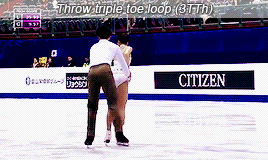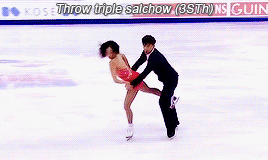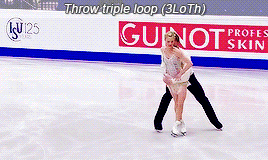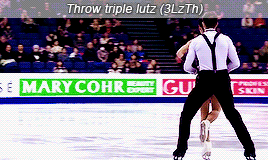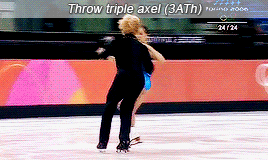
Introduction to Jumps in Pairs Skating
Introduction to Jumps in Pairs Skating
This guide will cover jumps in pairs skating, primarily throw jumps. We recommend reading the singles skating jump guide first, since jumps in pairs are the same as the jumps in singles.
More intro to skating guides are available here. Please do not reproduce any part of this post without permission.
LAST UPDATED: Jan 29, 2022
THROW JUMPS
Throw jumps are elements exclusive to pair skating where the male partner throws the female partner into a jump. Throw jumps appear on protocols with a “Th” after the name of the jump, and have lower base values than normal, unassisted jumps of the same name. One throw jump is required in the pairs short program and two are required in the free skate. There are six types of throw jumps, the same as in singles skating: toeloop (T), salchow (S), loop (Lo), flip (F), lutz (Lz), and axel (A). Throw flips and lutzes have the same base value. Pairs are not allowed to do both a throw flip and lutz of the same number of revolutions in the same program. In elite senior level skating, triple throw jumps are the norm. Some teams have landed quad throws in competition.
As in singles skating, throw jumps usually land on a backwards outside edge and the only difference between the jumps is the entry. The axel is the only jump with a forward entry.
—-
THROW TRIPLE TOELOOP (3TTh)
Yumeng Gao takes off from the outside edge of her right foot; her left toepick taps into the ice as Zhong Xie throws her.
—-
THROW TRIPLE SALCHOW (3STh)
Wenjing Sui takes off from the inside edge of her left foot as Cong Han throws her. Since the salchow is an edge jump, there is no toepick assistance.
—-
THROW TRIPLE LOOP (3LoTh)
Evgenia Tarasova takes off from the outside edge of her right foot without toepick assistance as Vladimir Morozov throws her. Notice how her legs appear crossed prior to takeoff, characteristic of the loop jump.
—-
THROW TRIPLE FLIP (3FTh)
Wenjing Sui takes off on the inside edge of her left foot; her right toepick taps into the ice as Cong Han throws her.
—-
THROW TRIPLE LUTZ (3LzTh)
Valentina Marchei takes off on the outside edge of her left foot; her right toepick taps into the ice as Ondrej Hotarek throws her. In throw flips and lutzes, one of the woman’s legs is between the legs of her partner during the setup for the jump.
—-
THROW TRIPLE AXEL (3ATh)
Rena Inoue takes off forwards from the outside edge of her left foot as John Baldwin throws her. The axel is easy to identify since it is the only jump with a forward takeoff. Only a few teams have attempted the throw 3A; Inoue/Baldwin are the first team to perform one in international competition, at the 2006 Winter Olympics.
SIDE-BY-SIDE JUMPS
Side-by-side (SBS) jumps in pairs skating are the same as in singles skating, but both partners must jump at the same time. They are abbreviated on protocols the same way as in singles protocols (ex. 3T for a triple toeloop).
One solo SBS jump is required in the short program and two sets of jumps are required in the free program. Of the two sets in the free, one should be a solo jump and another should be a combination or sequence. If one partner “pops” their jump (doesn’t do the planned number of revolutions), the lesser number of revolutions will be applied to the entire SBS jump. If one partner falls, the team gets a 1-point deduction. If both partners fall, they get a 2-point deduction.
